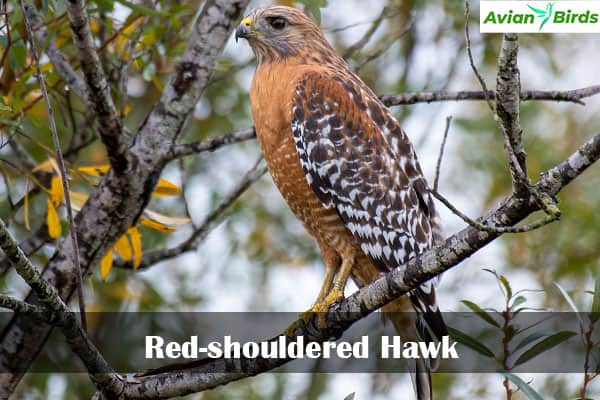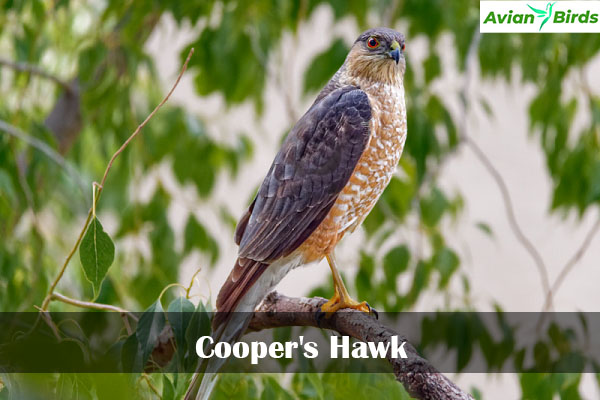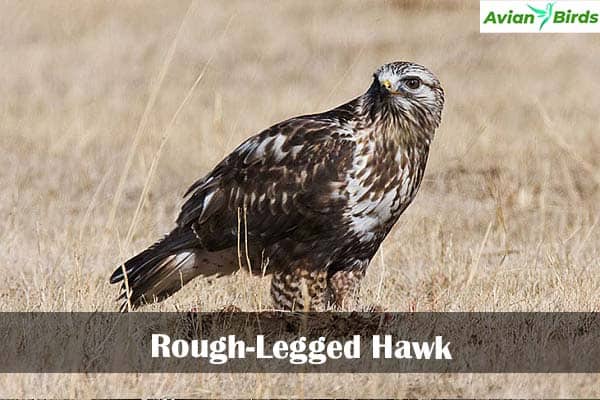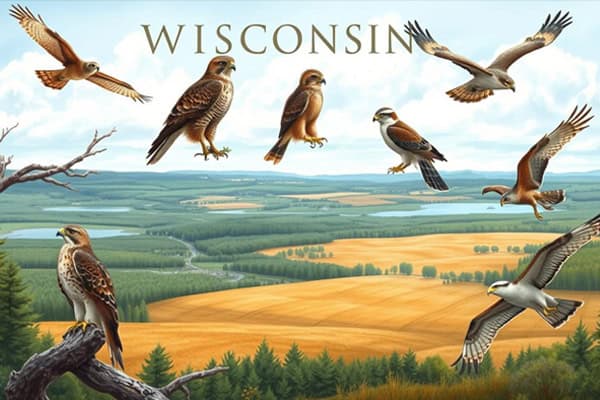7 Types of Hawks That Live in Michigan! (ID Guide With Pictures)
Do you love the Hawks in Michigan? These birds are thrilling with their sharp talons, sharp eyes, and fast hunting. You will see amazing hawks like the Red-tailed and Northern Harrier. Michigan is truly a place for these amazing feathered creatures.
Get ready to learn about the eight hawk species here. We’ll share how to spot them and talk about what makes each special. Dive into their worlds and learn where they live and how they act.
Overview of the Eight Native Species
- Red-Shouldered Hawk
- Northern Harrier
- Red-Tailed Hawk
- Cooper’s Hawk
- Sharp-Shinned Hawk
- Broad-Winged Hawk
- Rough-legged Hawk
- Northern Goshawk
Hawks are important for Michigan’s environment. They keep the populations of small animals, birds, and reptiles in check. Knowing about these hawks can make us value Michigan’s natural beauty more.
| Hawk Species | Habitat Preference | Hunting Strategies |
|---|---|---|
| Red-Tailed Hawk | Open fields, forests, and urban areas | Soaring and perch-hunting for small mammals and birds |
| Cooper’s Hawk | Forests, woodlands, and backyards | Agile pursuit and ambush tactics for smaller birds |
| Sharp-Shinned Hawk | Dense forests and woodlands | Rapid, maneuverable flight to catch small birds |
Michigan’s many landscapes are great for hawks. This lets them do their part in keeping nature in balance.
1. Red-shouldered Hawk
- Scientific name: Buteo lineatus
- Life span: 19 years
- Size: 16.9-24.0 in
- Weight: 17.1-27.3 oz
- Wingspan: 37.0-43.7 in
- Status: Least Concern
The Red-Shouldered Hawk is a common sight in Michigan. It is found all over the state and can be seen the entire year. These majestic birds stretch from southeastern Canada to Mexico and live in all eastern states. You can recognize them by their brownish heads, pale striped chests, and their long tails. They get their name from the red shoulders you see when they’re flying.

Habitat and Distribution
They live in deciduous swamps and bottomland hardwood forests. Thus, Michigan’s northern areas are perfect for them. They have been spotted across different Michigan counties. Cheboygan County has had the most observations, with 82 recorded. They have shown resilience and adaptability, appearing from 1974 to 2024 in various locations.
Nesting Behavior
Red-shouldered hawks are loyal and love their space. They often return to their old nests to raise young for many years. They start nest-building in April. Furthermore pick hidden spots in mixed woods by water to build, about 35-40 feet high in big trees. The male shows off his flying skills to impress the female during courtship.
Diet and Hunting Habits
These hawks hunt in woodlands. They sit on tall trees or fly over looking for food. Their main diet is small mammals like voles, mice, and moles. But they eat crayfish and birds too, if mammal numbers are down in winter.
Conservation Status
Once, these hawks were very common in North America. But, their numbers dropped when old forests were cut down in the 1900s. Since the 1950s, people have worked to protect them. Now, they are no longer in big danger. Stopping the use of harmful pesticides like DDT has also been a big help. This has kept their numbers stable in Michigan.
2. Northern Harrier
- Scientific name: Circus hudsonius
- Life span: 12 years
- Size: (46-50 cm)
- Weight: (300-750 g)
- Wingspan: (102-118 cm)
- Status: Least Concern
The Northern Harrier is a large hawk in Michigan all year. It’s known as the “Gray Ghost.” This hawk has grey feathers and a face like an owl. It stands out among Michigan’s hawk group.

Breeding and Nesting
Males Northern Harriers can mate with up to five females. Courtship starts in April. The males show off by diving and flying near their chosen female.
These hawks nest on the ground in places like grasslands. They build nests with twigs and soft materials. Sometimes, they build nests near each other.
Diet and Hunting Techniques
The Northern Harrier eats mostly small mammals and birds. It flies low over fields looking for prey. When it sees something, it dives and surprises it from behind.
This hawk is interesting for its looks, behavior, and hunting. It’s a thrilling find for anyone who enjoys watching birds.
3. Red-Tailed Hawk
- Scientific name: Buteo jamaicensis
- Life span: 10-15 years
- Size: 19.7-25.6 in
- Weight: 31.8-51.5 oz
- Wingspan: 44.9-52.4 in
- Status: Least Concern
The Red-Tailed Hawk is known all over Michigan. It’s the second-biggest hawk in the state. You can tell it by its short, red tail and brown and pale feathers. This hawk is found from Panama to Alaska, making it the most widespread hawk in North America.

Nesting and Breeding
In February, the male Red-Tailed Hawk shows off to the female to impress her. He flies high and dives near her. He might also bring her food. They often build nests in very tall trees or nest boxes. They reuse these nests year after year.
Diet and Hunting Strategies
These hawks in Machigian mostly eat small mammals like voles and rabbits. It will also go after birds. It hunts by waiting in trees or gliding above fields to catch prey by surprise.
Conservation and Population Trends
During the last century, Red-Tailed Hawks in Michigan have spread more. This might be because forests became smaller due to logging. They face dangers like shootings and poisoned food. But, they are still very common in Michigan and all over North America.
4. Cooper’s Hawk
- Scientific name: Accipiter cooperii
- Life span: 12 years
- Size: 14.6-15.3 in
- Weight: 7.8-14.5 oz
- Wingspan: 24.4-35.4 in
- Status: Least Concern
The Cooper’s Hawk is a medium-sized bird found across North America, reaching down to Mexico. It’s known for living in forests and is great at hunting. It’s often confused with the Sharp-Shinned Hawk but can be told apart because it’s bigger and has distinctive marks.

Nesting and Territorial Behavior
In March, the breeding season starts for Cooper’s Hawks. The males perform high-flying shows to impress females. Once a pair is formed, they mark their territory with slow, soaring flights. Their nests are usually high up in trees, placed on large branches or old nests.
Diet and Hunting Tactics
Cooper’s Hawks feed mainly on small birds, catching them mid-air or off branches. Sometimes, they eat small mammals. For these meals, they use less flashy hunting methods.
Population History and Conservation
Since the 1900s, Cooper’s Hawk numbers have seen big changes. Their population tripled quickly but then fell due to hunting. After laws against hunting, their numbers went up again.
Then, the pesticide DDT caused another decline. Now, they’re better protected, but poisoning from eating bad prey is still a challenge.
| Statistic | Value |
|---|---|
| State Distribution | The Cooper’s hawk is classified as an uncommon permanent resident in Michigan, scattered throughout most of the state, with a higher likelihood of encounters in the southern half. |
| Nesting Records | During the Breeding Bird Atlas Project, 84 blocks in Michigan showed confirmed breeding records, while 450 blocks reported probable or possible breeding records, with southwestern counties having the highest concentration of occurrences. |
| Best Survey Time | The optimal time to survey active Cooper’s hawk nests is from late March to early May, with nest building reported from 23 March to 20 April in southeastern Michigan. |
| Habitat | Cooper’s hawks in Michigan are found in various forest types, with recent studies showing nesting habitat dominated by oak, hickory, and scattered pine in urban areas, with woodlots ranging from 0.12 to 0.61 ha. |
| Biology | Cooper’s hawks lay three to five eggs, incubated for about 34-36 days, and young typically fledge at about five weeks of age, beginning to breed at two years old. Prey includes birds mostly, with hunting behavior combining still-hunting and surprise attacks. |
| Conservation/Management | Primary threats to Cooper’s hawks in Michigan include habitat alteration due to development activities like timber harvest, road construction, and residential development. Shooting and trapping, historically damaging, still pose limited threats. Contaminants were historically significant but recent research shows lesser impact. West Nile virus effects remain unclear. |
| Research Needs | Research on inventory, distribution patterns, productivity, reproductive success, impacts of silvicultural practices, effects of urbanization, predation, contaminants, competitors’ effects, habitat analysis, and micro-habitat features within the Cooper’s Hawk home range are needed in Michigan. |
5. Sharp-Shinned Hawk
- Scientific name: Accipiter striatus
- Life span: 5 years
- Size: 9.4-13.4 in
- Weight: 3.1-7.7 oz
- Wingspan: 16.9-22.1 in
- Status: Least Concern
The Sharp-Shinned Hawk is the smallest hawk found in Michigan and the U.S. They have a grayish back and an orange chest. This can make them look like the larger Cooper’s Hawk. Yet, Sharp-shinned hawks have a narrower tail with stripes.

Identification and Similarities to Cooper’s Hawk
Adult sharp-skinned hawks are slate blue-gray with dark tail bands. Young ones are brown with yellow eyes and brown streaks. They fly with rapid beats and short glides. The white-breasted Sharp-shinned Hawk has unmarked white underparts and a white cheek.
Sharp-shinned Hawks in Michigian look similar to Cooper’s Hawks but are smaller. Males are the size of an American Kestrel. Females are a bit bigger, almost the size of a male Cooper’s Hawk.
Nesting and Courtship
In courtship, Sharp-shinned Hawks soar together above trees, calling. Males dive close to females, showing off. They nest in dense conifer trees near trunks to hide.
Diet and Hunting Methods
Sharp-shinned hawks wait in bushes or trees for prey. They eat small birds and mammals. Their agility lets them catch birds in mid-air.
6. Broad-Winged Hawk
- Scientific name: Buteo platypterus
- Life span: 12 years
- Size: 13.4-17.3 in
- Weight: 9.3-19.8 oz
- Wingspan: 31.9-39.4 in
- Status: Least Concern
The Broad-Winged Hawk flies high over Michigan’s forests, catching everyone’s eye. It’s slightly smaller than a Red-shouldered Hawk. Broad-winged Hawks are seen a lot in Michigan in spring and summer.

Nesting and Breeding Behavior
Male Broad-winged Hawks show off in April to attract their mates. After pairing up, they build their nest high in the forest trees. Nests are mainly found along the Tennessee River up to Maine.
Diet and Hunting Adaptations
These hawks eat a wide range of small animals. They enjoy voles but also eat frogs, insects, birds, and some reptiles. Their hunting style is from low perches. They swiftly grab prey with their sharp talons.
Conservation Challenges and Efforts
The biggest problem for these hawks is losing their forest homes. As the woods break into smaller areas, it’s harder for them to nest. Despite this, their numbers are growing, thanks to conservation in the U.S.
With the help of conservationists, the Broad-Winged Hawks are facing their challenges and doing well. Protecting the forests and stopping habitat loss is crucial. It’s how we can keep these wonderful birds flying over Michigan for years.
Read Our Previous Articles:
7. Rough-legged Hawk
- Scientific name: Buteo lagopus
- Life span: Up to 15 years
- Size: 18-20 in (46-51 cm)
- Weight: 1.5-3.25 lbs
- Wingspan: 52-54 inches
- Status: Least Concern
The Rough-Legged Hawk is a truly special bird of prey. It lives in the far north of the Arctic, making it unique. You can see them in Michigan’s winter when they fly south. They appear in places like fields and prairies.

These hawks stand out with their dark, bold patterns. They have feathered legs that keep them warm. This makes them both beautiful and well-adapted.
Rough-legged hawks are excellent hunters. They search for prey by hovering in the wind. Their unique style in the air catches the eye. Despite some challenges, these birds are doing well. You might just see one flying in Michigan.
Frequently Asked Questions About Hawks In Michigan
Q1. What kind of hawks are in Michigan?
The most common hawk in Michigan is the red-tailed hawk.
Q2. What is the difference between a hawk and a falcon?
Hawks are generally larger with broader wings and tails, while falcons are smaller, faster, and have pointed wings.
Q3. Are the Hawks in Detroit?
Yes, hawks can be found in Detroit and its surrounding areas.
Q4. Do hawks migrate in the winter in Michigan?
Yes, some hawks migrate south for the winter, but species like the red-tailed hawk may stay in Michigan year-round.







